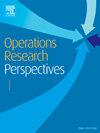The selective multiple depot pickup and delivery problem with multiple time windows and paired demand
IF 3.7
4区 管理学
Q2 OPERATIONS RESEARCH & MANAGEMENT SCIENCE
引用次数: 0
Abstract
A recurring challenge for transportation companies is the inefficiency of returning (partially) empty vehicles, or backhauling, after delivering orders. To address this issue, companies search on freight exchange platforms for profitable pickup and delivery orders, aiming to reduce the costs associated with empty return trips. The increasing reliance on freight exchange platforms presents both an opportunity and a challenge: while they offer access to profitable loads, effectively selecting the right combination of orders to maximize returns is challenging. This paper addresses this challenge by introducing the Selective Multiple Depot Pickup and Delivery Problem with Multiple Time Windows and Paired Demand (SMDPDPMTWPD). We formulate the SMDPDPMTWP as a Mixed-Integer Linear Program (MILP) to maximize profit and optimize freight selection for return trips. In addition to the main model, three problem extensions are proposed: (i) profit maximization including CO2 costs, (ii) soft time windows, and (iii) soft time windows including CO2 costs. Given the complexity of the problem, we develop an Adaptive Large Neighborhood Search (ALNS) metaheuristic to solve large instances within reasonable computing times and compare it with a Simulated Annealing (SA) heuristic. Results show that ALNS outperforms SA and finds the same optimal solutions as the MILP formulation for small instances. Furthermore, ALNS achieves an average improvement of 308.17% over the initial solutions for the profit maximization variant. The model variant with CO2 costs shows a slight sensitivity of the routing schedules to the CO2 emissions costs, whereas we observe a significant change when allowing soft time windows. Finally, soft time windows significantly increase the profits earned compared to the hard time windows (179.54% on average), due to the additional flexibility created when late arrivals are possible.
具有多个时间窗口和成对需求的选择性多仓库取货问题
运输公司面临的一个反复出现的挑战是,在交付订单后,返回(部分)空载车辆或回程的效率低下。为了解决这个问题,公司在货运交易平台上寻找有利可图的取货和送货订单,目的是减少与空回程相关的成本。对货运交易平台的日益依赖既带来了机遇,也带来了挑战:虽然它们提供了有利可图的货物,但有效地选择正确的订单组合以最大化回报是一项挑战。本文通过引入具有多时间窗口和配对需求的选择性多仓库取货和交付问题(SMDPDPMTWPD)来解决这一挑战。我们将SMDPDPMTWP制定为一个混合整数线性规划(MILP),以最大化利润和优化往返的运费选择。在主要模型的基础上,提出了三个问题扩展:(i)包含CO2成本的利润最大化;(ii)包含CO2成本的软时间窗;(iii)包含CO2成本的软时间窗。考虑到问题的复杂性,我们开发了一种自适应大邻域搜索(ALNS)元启发式方法来在合理的计算时间内解决大型实例,并将其与模拟退火(SA)启发式方法进行比较。结果表明,对于小实例,ALNS优于SA,并找到与MILP公式相同的最优解。此外,对于利润最大化变量,ALNS比初始解平均提高了308.17%。考虑二氧化碳排放成本的模型变量显示出路线调度对二氧化碳排放成本的轻微敏感性,而当允许软时间窗时,我们观察到显著的变化。最后,与硬时间窗口相比,软时间窗口显著增加了获得的利润(平均为179.54%),这是由于在可能出现延迟到达的情况下创造了额外的灵活性。
本文章由计算机程序翻译,如有差异,请以英文原文为准。
求助全文
约1分钟内获得全文
求助全文
来源期刊

Operations Research Perspectives
Mathematics-Statistics and Probability
CiteScore
6.40
自引率
0.00%
发文量
36
审稿时长
27 days
 求助内容:
求助内容: 应助结果提醒方式:
应助结果提醒方式:


